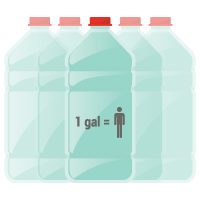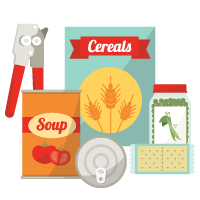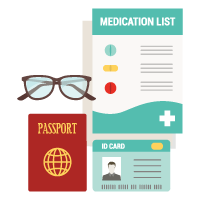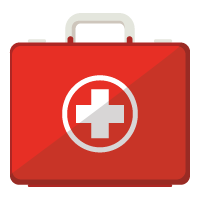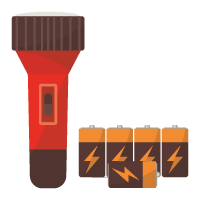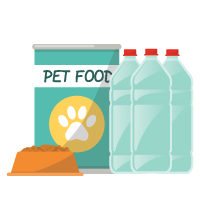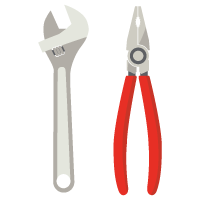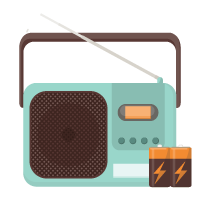Prepare for the Unexpected: Building Your Essential Earthquake Emergency Kit
Your earthquake emergency kit will make sure you have all you need at your fingertips and address any injuries until help arrives. Follow these earthquake kit tips to create an emergency preparedness kit for disaster preparedness, filled with survival supplies to keep your family prepared for the next big one.
Creating an earthquake kit or supplementing a pre-made kit is an opportunity for your family to talk about what you would do when a major earthquake strikes. General guidelines recommend storing enough food, water and gear for three days per person (72 hours) in your household.
Keep in mind this is not a go-kit. This is a stay-in-place survival kit. These are supplies for home to go in a box, backpack or earthquake bag. Keep it where you can reach it.
Lessons from Loma Prieta: Don't Be Left Without These Essentials Supplies After an Earthquake
After the 1989 Loma Prieta earthquake, 12,000 Bay Area residents were displaced from their homes. Of those whose dwellings remained intact, many were without water, electricity and phone service for days. Important supplies to have on hand include:
- Three days’ water supply for each member of your family (at least 1 gallon per person, per day)
- Three days’ supply of nonperishable food, plus a can opener
- First aid kits for your home and autos
- Three days’ supply of food and water for your pets
- Flashlights in every room with extra batteries
- Power packs for phones
- Prescription medications
- Whistle
- Swiss Army knife
- Copies of your personal documents
- Extra pair of glasses
- Cash, small bills are best
Remember to refresh water and food items every six months.
From Canned Fruits to Energy Bars: A List of the Best Non-Perishable Foods for Earthquake Preparedness
Choose foods in easy-to-open or serve packaging, and have a manual can opener in your emergency kit. It is important to choose foods that will not increase thirst in your earthquake survival kit.
- Ready-to-eat canned meats, fruits, veggies
- Canned juices, milk, soup
- Sweetened cereals
- Salt, pepper, sugar
- Peanut butter, jelly, crackers
- Granola bars, trail mix, dried fruit
- Cookies, hard candy, instant coffee, tea bags
Department of Homeland Security’s Ready.gov website says that refrigerated foods are safe to eat if the power hasn’t been out for more than four hours. Try to keep the refrigerator and freezer doors closed as much as possible to avoid spoilage.
Essential Items for an Earthquake-Ready First Aid Kit
Your home first aid kit can help reduce the risk of infection or the severity of an injury. First aid kits typically include a variety of supplies that will help treat cuts, scrapes and minor injuries, including sprains and burns. Build on the basic first aid kit and print out a copy of the list to keep with first aid items.
Basic first aid kits should include the following items:
- Adhesive bandages, in all sizes
- Butterfly closures, in all sizes
- Tape roll
- Gauze pad and gauze roll
- Scissors
- Foil blankets
- Examination gloves
- Flashlight/glow sticks
- Instant cold pack
- Hot pack (body warmer)
- Antiseptic cream
- Aspirin or Acetaminophen
- Allergy medication
- Tweezer
- Burn cream
- Alcohol pads
- Antiseptic towelettes
- Finger splints/tongue depressors
- Cotton swabs
- Eye wash
- List of family member's medical history, medications, doctors, insurance company, and contact persons should be readily available.
From Shutting Off Gas to Purifying Water: Must-Have Tools for Repair and Survival After an Earthquake
In times of emergency, it is important to have tools available that will help you turn off the water or gas, mend broken appliances, and heat water.
- Flashlight with extra batteries in every room
- Fire extinguisher
- Duct tape
- Work gloves
- Matches in a waterproof container
- Knife, pliers and scissors
- Local maps (paper)
- Manual can opener
- Dust mask
- Water purification tablets
- Sterno
- A water-resistant or waterproof tarp, which may be needed for shelter, or to protect property from the elements or contain debris after an earthquake.
Equipping Your Home for Communication After Earthquakes
When disaster strikes, power sources are one of the first things to go, and they can often stay off for weeks at a time. Make available in every room of your home a pack of glow sticks and simple flashlights, which are easy to carry and store. Be sure to include extra batteries for the flashlights!
Once the power goes out, radio waves may be your only connection with the outside world. Any battery-powered AM-FM radio is crucial during an emergency, but many models now include solar panels and hand cranks to power their rechargeable batteries.
Cellphones and tablets are great survival tools, because you can download all kinds of useful information and use it for reference in times of need. But those devices are useless once they run out of power. Power packs can provide multiple charges to prolong the life of your devices, until you find a place to recharge.
Building Your Car's Earthquake Preparation Kit
We Californians spend a lot of time in our cars: commuting, running errands, enjoying the outdoors. In addition to your home earthquake critical supplies, you will need to prepare a car earthquake emergency kit. The purpose of the kit is to provide basics in case a major earthquake strikes while you are on the road, or you directed by a civil authority to leave your home quickly.
Supplies recommended for your car include:
- Keep your tank ½ full
- Water supply for 3 days
- Nonperishable food supply for 3 days
- Extra clothing and shoes
- Small first-aid kit
- Solar blanket or sleeping bag
- Flashlights and batteries
- Toilet tissue and trash bags
- Swiss Army knife
- Fire extinguisher
Prepare Essential Supplies for Keeping Your Pets Safe After an Earthquake
If you have one or more four-legged family members, your earthquake emergency kit should include supplies for your pets. Consider this pet earthquake kit list:
- Sturdy leashes, harnesses and carriers for transport
- Food and drinking water for 10 days
- Cat litter/pan, scooper and trash bag
- Doggie disposal bags and disposable gloves
- Bowls, treats, toys, blankets
- Medications and copies of medical records
- Current photos of you with your pets/s in case they get lost
- Information on feeding schedules, medical conditions, behavior problems and contact information of your vet in case pets have to be fostered/boarded
Make sure your pets are microchipped and outfitted with current ID tags. Pets should be current on their vaccines in case they end up in a shelter.
Also, decide which friends, relatives, boarding facilities, animal shelters or vets can take care of your animals in an emergency. Have contact names and numbers printed out and kept in your kit.
What Critical Supplies should be in a basic Earthquake Kit?
Most experts say that we should have at least three days supply of food, water and supplies set aside in case of an emergency. This is to account for the time it may take for rescue workers to reach you after a major disaster.
Creating an earthquake kit or supplementing a pre-made kit doesn’t have to be expensive. Many items are inexpensive and can be found at many big box stores.
The Sacramento Bee newspaper priced the cost for a basic earthquake safety kit below:
| Item | Cost |
|---|---|
| 2 ½ Gallons of water per person | $3.09 |
| 4 boxes of granola bars per person | $10.00 |
| 4 cans chicken noodle soup per person | $3.96 |
| Portable AM/FM digital radio | $19.99 |
| Hand sanitizer | $2.99 |
| First aid kit | $13.49 |
| Swiss Army knife | $14.99 |
| Flashlight/lantern | $9.89 |
| Whistle | $4.99 |
| Large box of matches | $0.92 |
| 12 small rolls of TP | $2.97 |
| Total with tax | $104.05 |
How to Prepare for an Earthquake
The key to being safe during an earthquake is preparation. While an earthquake safety kit will be of help after an earthquake, nothing replaces the conversations you have with your family members before an earthquake.
Create an earthquake safety plan for you and your loved ones which includes your stay-in-place safety kit.
- Be sure to identify safe places in each room of your home.
- Practice Drop, Cover and Hold On with each member of your household.
- Make or purchase an earthquake safety kit. Make sure to have water and snacks available in each room of your home.
- Discuss with your family what to do, where to meet if separated, and how you will communicate when an earthquake strikes. Check work, childcare, and school emergency plans.
- Don’t rely on doorways for protection. During an earthquake, get under a table or desk. Hold on until the shaking stops.
- Pick safe places in each room of your home.
- Identify an out-of-the-area friend or relative that family members can check in with. Text messages often go through when regular phone calls won’t work, so don’t give up if you can’t make a call.
- Secure water heaters according to California law, and major appliances and tall, heavy furniture to prevent them from toppling.
- Keep sturdy shoes near your bed. The most frequent injuries from earthquakes come from stepping on broken glass.
- Be mindful that roads, electricity, cell, police, and fire services will be impacted and most likely interrupted.
Understand Geologic & Structural Risks to Your House
Learn about the potential geologic and structural threats to your home in case of a major earthquake. The violent shaking from earthquakes can:
- Rupture the earth,
- Trigger landslides, and
- Turn the surface of the earth to liquid.
If your home was built before 1980, it may also be vulnerable to serious structural damage.
Protect Your House Before a Major Earthquake
When the 7.1 Ridgecrest quake hit SoCal in 2019, several fires started, chimneys collapsed, and there were breaks in water mains. This came a day after the 6.4 earthquake affected the same area.
CEA’s affordable and flexible home earthquake policies protect your home before the big one strikes. Our policies:
- Offer extended choices of coverage and deductibles.
- Protect the investment in your home.
- Provide you with peace of mind.
Most standard home insurance policies and renters insurance don’t include earthquake coverage. A separate earthquake policy is required to cover shaking damages.
Whether you are a homeowner, mobilehome owner, condo-unit owner or renter, there is a policy to fit your needs and budget. Get started today with an estimate!
Is Your House at Risk for Earthquake Damage?
California is earthquake country with nearly 16,000 known faults. Each region of the state holds earthquake risk. Most of us live within 30 miles of an active fault.
Know your risk. Find out about faults near you and the hazards that pose a danger to your home. Visit CEA faults by county tool.
Get an Earthquake Insurance Estimate!
Find out if CEA residential earthquake insurance is right for you with an estimate. Without earthquake insurance, you will be responsible for all of the costs to repair or replace your belongings after a major earthquake. Choose deductibles from 5% to 25%.

